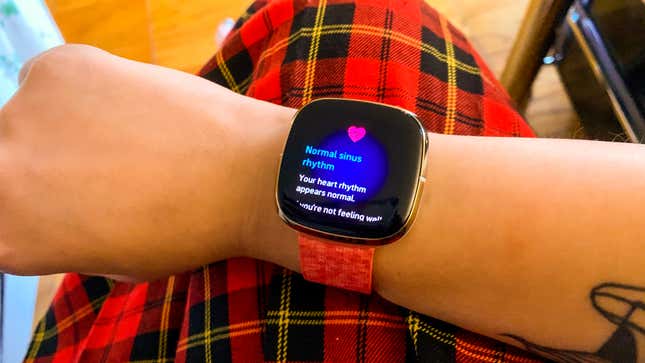
Last month, the Food and Drug Administration said Fitbit could have a little treat in the form of clearance for its ECG app. As of today, that app is now live for anyone in the U.S. (as well as some countries in Europe and Asia) with a brand spanking new Fitbit Sense.
Before you can take a heart reading, you’ll have to do a little word reading first. To get started, navigate to the Discover tab in the Fitbit app, scroll down to Assessments & Reports, and then select Heart Rhythm Assessment. You’ll be asked to confirm that you’re 22 years old or older, don’t have a pacemaker, and acknowledge that whatever results you get, the Fitbit Sense isn’t providing you with a diagnosis and that it can’t detect heart attacks, blood clots, or a stroke.
Once you’ve done that, you’ll get some more reading about the types of results you could possibly get: Atrial fibrillation, normal sinus rhythm, and inconclusive. The first two are self-explanatory, though if the watch says you’ve got Afib, you should definitely talk to a doctor for a proper diagnosis. If your result is inconclusive, it’s likely because your heart rate is outside of the 50-120bpm range. This limitation isn’t a ding on Fitbit—Apple also had issues with heart rates above 120bpm with its ECG app, something that was just improved with the launch of the Apple Watch Series 6.
Once you’ve done all the reading, you can then take an ECG reading. The ECG apps should already be on the Fitbit Sense—I just synced to the Fitbit app and boom, it was already there on my watch, though I had to swipe through some of the menu screens to find it.
As with other ECG-capable smartwatches, it’s best if you sit still and rest your arm on either a table or some kind of flat surface. In the app, you select which wrist you’re wearing the Sense on, and then all you have to do is put your index finger and thumb on opposite corners of the Sense’s metal frame. The whole thing takes about 30 seconds and is easy peasy. If you want a PDF report to share with your doctor, you can just go back to the Assessments & Reports section in the Discover tab, tap Heart Rhythm Assessment, and your results should pop up.

Overall, the process feels very similar to how you would take an ECG on the Apple Watch. I tried it twice and both times got a normal sinus rhythm, which I love for me, personally. The one thing I would say is that getting your reports is a smidge easier on the Apple Watch, but this definitely isn’t a dealbreaker.
In any case, this is great news for Android users interested in advanced heart health features. While Samsung also got FDA clearance for its ECG feature this year, when it finally went live a few weeks ago, it turned out ECGs were only available to folks with Samsung phones with Android Nougat or higher. This gives ECG access to a much larger group of Android users. Now if only we could get an LTE capable Fitbit, we’d be all set.